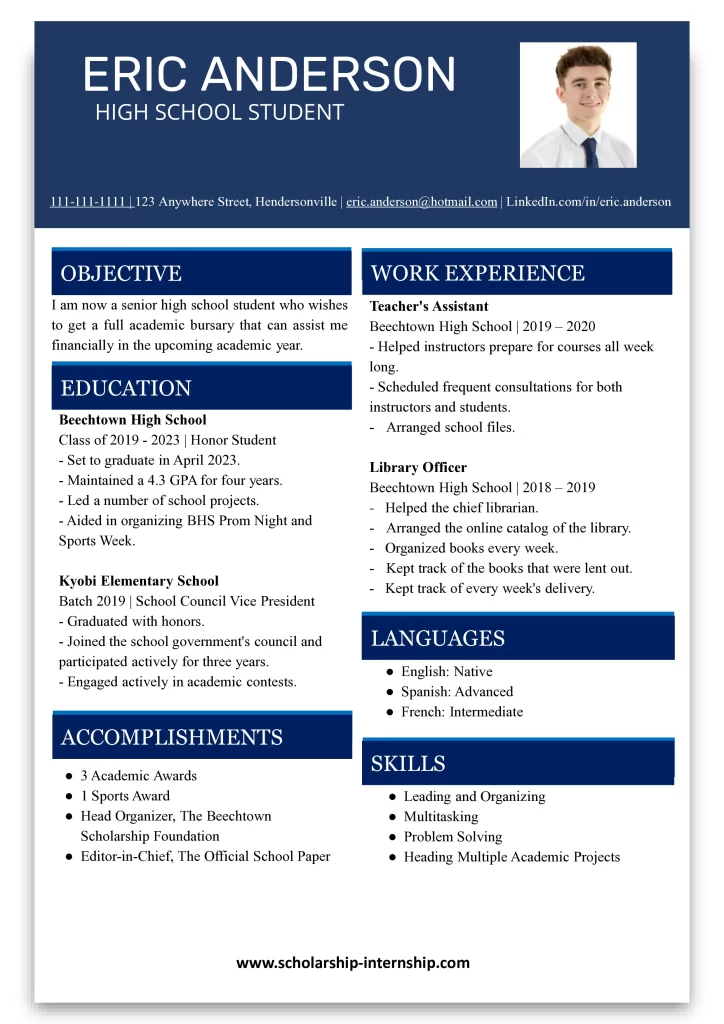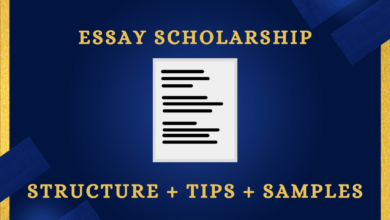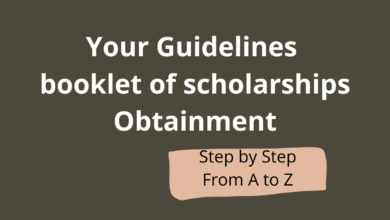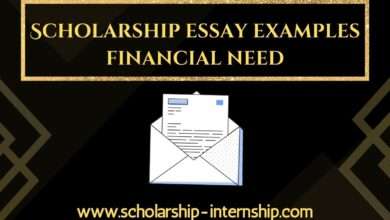Strong Resume for Scholarship, How to Write? Template & Samples

Writing an exceptional resume for a scholarship is a very important step to getting your dream scholarship and improving your future career. So, if you are willing to get a scholarship, you need first think about how to make your resume stand out.
When submitting an application for a scholarship, your Curriculum vitae (CV or Resume) frequently serves as the first evaluation filter to ensure that you meet the basic criteria of the call, that your expertise is relevant to the program you want to apply to, and that you are a candidate with the potential to succeed in academic, professional, and personal endeavors.
In this article, we will go into great depth regarding how to write CV for scholarship, and provide scholarship resume template and Scholarship Resume Examples, so if you intend to write a strong Curriculum Vitae for scholarship, you are in the right place
Content
- What is a Resume for Scholarship?
- Why Do Scholarship Committees Ask for Resume for Scholarship?
- Reflect and Brainstorm your Academic Resume for Scholarship
- How to Organize Academic Resume for Scholarship?
- How to Write a Winning Curriculum Vitae for Scholarship?
- Resume Format for Scholarship Application
- Resume for Scholarship Template
- Frequently Asked Questions About Curriculum Vitae for Scholarship
- Scholarship Resume Examples
- Summary
What is a Resume for Scholarship?
A CV is a presentation of your accomplishments and achievements. This would include details about your academic background, in addition to your extracurricular activities and involvements, for students applying for bursaries. An in-depth 1-page document should condense all of this material.
Writing a Curriculum Vitae for scholarship may be challenging since you must keep it brief and focused on the most crucial details. After all, many members of the scholarship committee could scan your résumé in under a minute!
Why Do Scholarship Committees Ask for Resume for Scholarship?
The question “Why do scholarship committees want to read my Curriculum Vitae for scholarship?” may be on your mind. This is a legitimate question, and from my perspective, the CV is beneficial since it provides a more thorough explanation of your interests and achievements. Also, a curriculum vitae facilitates the logical, unambiguous organization of everything (assuming that the candidate has a logical, organized CV).
The academic CV’s purpose is to catch the scholarship provider’s attention so that the cover letter may continue to persuade him that your application is the best qualified among all others. A poorly thought-out Curriculum Vitae for scholarship might result in scholarship rejection.
Due to this, the resume for scholarship is among the most crucial documents used in the evaluation process. Based on our knowledge gained from receiving scholarships and successfully assisting others with their application processes, we would like to share some advice with you.
Reflect and Brainstorm your Academic Resume for Scholarship
You should evaluate yourself and decide which aspects of your academic, professional and personal experience you will include on paper before you can begin to write your curriculum vitae.
To have a more comprehensive understanding of what you have to give, you should first collect as much information as you can. Then, you should decide which information to present and how to do it. Research the scholarship provider and the type of applicant he is looking for, keeping in mind that they have the final say. Choose and emphasize the most pertinent abilities and experiences in your Cv in light of this.
You can get a head start on your research by carefully reviewing the scholarship’s description and criteria. Also, you may go through the profiles of other awardees. You have the chance to assess their profile since scholarship providers frequently provide either articles or institutional videos in which other academics share their experiences.
When doing research, make a list of keywords and use them to help you create your Resume (CV). You’ll be able to decide, for instance, whether to place greater emphasis on your academic, professional, or personal talents and experiences. It may also be useful in determining whether you should demonstrate more of your leadership, creativity, social consciousness, or research skills.
How to Organize Academic Resume for Scholarship?
Students may think that there is only one correct way to write a Curriculum Vitae for scholarship, but the fact is that it is not completely true. Even if you look at the evidence and examples provided by the most prestigious universities in the world, you will find many differences between them in terms of the sections included, the order of their appearance in the resume, and how the information is presented.
Contact details, educational background, and work experience are required to be included on all CVs. But, I advise you to include more sections that make it simpler for the reader to recognize pertinent traits, like languages, technical and software skills, certifications and acknowledgments, Volunteering and other experiences.
Contact
You need to include your full name, address, and phone number, as well as your email in the header or at the top of the page. Refrain from using terms like “CV,” “Curriculum Vitae,” or “Resume” in your Curriculum vitae for scholarship, because they lack a professional appearance.
Note: Be careful to use a formal email address on your Resume, such as FirstnameLastname@email.com.
It’s also typical for academics to give other contact details, such as your:
- Google Scholar Profile, ORCID, and/or NCBI Bibliography
- link to a professional website or Github
Education (Academic Background)
It will enable you to demonstrate that you fulfill the minimum admission criteria. For instance, if you are applying to a Doctoral program, you already have a Master’s degree under your belt; if you are applying to a master’s program, you already have an undergraduate degree.
In reverse chronological order, you should list your educational history, beginning with the university you are presently enrolled in (or most recently graduated from). Provide your attended institutions, degree obtained, and graduation date for each entry.
If you are preparing an undergraduate Resume and don’t yet have much experience, emphasize accomplishments in your education section, like your Grade Point Average, whether or not you were on the Dean’s list and pertinent coursework.
Work Experience (Work Background)
Don’t only focus on outlining the tasks you completed; also mention your achievements and quantitative outcomes. By doing this, you are showing the reader that you leave a mark at your workplace and that you are conscious of the impacts of your work. Keep in mind that it is about what you have done, so you are the main focus of what you provide.
For instance, it is preferable to write ” I boosted sales by 30 percent over the same period last year” rather than “sales & event organization”. Always state the facts in plain language.
Languages
Indicate the languages you are fluent in along with their level (native, basic, intermediate, or advanced). Stay away from complicated numerical scales that are hard for the reader to grasp.
Personal Skills
Mention your soft skills in addition to your technical ones. This part of your CV is crucial so that the reader can see right away if you meet the criteria he is looking for. You may also exhibit self-awareness and balance by doing this.
Other Key Sections
If you have written publications or have been granted awards or certificates that complement your official academic training, you can arrange them in a section to showcase your accomplishments. Also, provide links (DOI numbers) to your publications if available. Similarly, if you have experiences with extracurricular activities or volunteer work, I advise you to group them together in another section to clearly show your initiative and social awareness. You can also put extracurricular activities in the “Education” section and volunteer work in the “Work Experience” section.

How to Write a Winning Curriculum Vitae for Scholarship?
Now that we’ve covered the areas you need to include on your academic resume, Here are some tips for crafting a Resume that will improve your chances of getting the scholarship you want.
A poorly thought-out CV for a scholarship may result in scholarship rejection. We’ve outlined these strategies to make your academic Resume (cv) appear strong and successful.
Make your Curriculum vitae for scholarship brief and precise
Be accurate and specific without going on for too long. The reader of your Resume will only have about 30 seconds to read it, depending on the volume of applications. Because of this, you should strive to fit as much material as possible onto no more than two pages.
Delete any non-essential personal data, such as age, gender, marital status, and/or religious affiliation.
Simple format, but NOT flat
To highlight important information for the reader, use bullets, bold type, and capital letters. To make reading easier, it is also advised to use more than 1 column and clearly delineate the parts. Unless you are applying to a programme in the arts, stay away from unique patterns and color combinations.
While providing information in your curriculum vitae for scholarship, be detailed. identifies institutes, titles, & dates. The data must be presented in chronological sequence, starting with the most recent information.
Know your audience
Writing a Curriculum vitae for scholarship with the intended audience in mind is one of the most frequently forgotten steps in the process. For instance, you should modify your resume according to the department or industry you’re applying for.
What do they prioritize above anything else? Research? educational background? Publications? Regardless of what it is, be sure to include it first on your resume so the department head can easily find it.
Moreover, discover more about the qualities that the institution is looking for in an applicant by conducting internet research on prior candidates and their experiences or by speaking with senior advisors or experts in your industry. Some institutions provide a scholarship resume template and/or Scholarship resume examples. Make sure to have a look at them if available.
Avoid using a lot of technical jargon in your Curriculum vitae for scholarship
Not just other academics in your discipline, but everybody who reads your resume for scholarship should be able to understand it with minimal effort.
That’s because when considering your application, institution admissions departments, hiring committees and grant reviewers might not be familiar with all the technical language from the industry you work in. Furthermore, even other academics in your industry might not be familiar with the same methods you have previously employed.
When department heads read your resume, your research & publications will speak for themselves. Everything else should be written in a way that is simple to read and comprehend.
Definitive and sincere:
As the institute may occasionally verify the information you include on your Curriculum vitae for scholarship, you need to make sure that everything you include is accurate. Don’t tend to run into the danger of giving inaccurate information, since this might get you into trouble.
Save your academic resume for scholarship as a PDF
To ensure the layout of your application resume is preserved, save it as a PDF when you’ve completed composing it.
Keep your content organized
Academic resumes can be substantially lengthier than a typical CV length (more than one page). Include your name & page number on every page to make it easier for reviewers to obtain information and to maintain your application materials organized.
Reflect the reader’s level of priority
CV writing is an art, not a science. The objective is not to cram your information into a certain design but to find a structure and style that emphasizes your expertise and talents. The order and emphasis of your sections must also reflect the reader’s level of priority.
Never embellish the facts; always be sincere
Avoid putting false or inaccurate information in the resume for a scholarship, as every detail you provide in the Curriculum Vitae for scholarship may be validated, and therefore providing incorrect information to embellish the truth may put you in an embarrassing position and keep you away from the competition.
Resume Format for Scholarship Application
- Make sure that your Curriculum vitae for scholarship is readable by using a neat font
- Your resume’s font is important since it makes a first impression. While creating a resume for scholarship Resume, you should use a neutral font. Choose Calibri, Arial, or Times New Roman as your font. The best fonts to use for highlighting words are Georgia, Garamond, and Cambria. While drafting a Resume, a font size of 10-12 points is recommended.
- Never be afraid to use the formatting commands for Bold, Underline, Italic and capitalization as necessary to draw attention.
- Use bullets for your contribution and accomplishments points
- Make your headers bigger (14 – 16 points).
- Set margins of at least one inch.
- Don’t use passive or weak phrases
- Start your sentences with action words
- Remove all “I” and “we” and other personal pronouns.
- Maintain a uniform style for the tenses, dates, punctuation, and space.
- Professionally review and edit your curriculum vitae. There should be no grammatical or spelling mistakes on your Curriculum vitae for scholarship.
- Strategically place the most important information near the top and/or left side of the page.
- Avoid using clichés and instead highlight something exceptional about yourself.
After knowing these key tips, we offer a scholarship resume template in order to help you save time and effort.
Resume for Scholarship Template
Here is a resume for scholarship sample template that you can copy and paste into Google Documents or Microsoft Word. Make sure to fill out your scholarship resume template with correct and precise details.
Resume for scholarship template:
1. CV Heading
Applicant’s first & last name
Email address| Phone number| Address | Linkedin
2. CV Goal
[Current academic status] with a passion/ interest in [related subject(s)], and [amount] of [volunteer, work, or internship experience] excelling at [responsibilities & duties]. Seeking [bursary name] to pursue [degree]. Planning to pursue research in [research/thesis topic related to your discipline].3. Academic Background
Name of the Institution
Degree
Grade point average
Related Coursework:
Include at least 3 courses that are pertinent to the university subject you plan to pursue.
Activities beyond the classroom:
Include your interest in sports and competitions, community service, and/or societal memberships (fraternity, band, etc.)
4. Work Background
Title of the Position
Company
Dates
Add any employment, volunteerism, or internships you’ve had.
It’s OK to list work even if it has nothing to do with the career you’re pursuing. But make an effort to emphasize applicable transferable skills.
Attempt to define your responsibilities and duties by describing your work experience with precise statistics.
5. Honors & Awards
Add notable academic achievements to your Curriculum Vitae for scholarship like prior grants, competition victories, publications, and Dean’s List honors.
6. Important Skills
Include in your CV for scholarship application any hard skills, like technical, software, and linguistic abilities, that you have that are relevant to the profession you’re seeking.
Even if you have just had unrelated work experience, it’s likely that you possess soft skills like leadership, cooperation, and communication that are excellent to highlight.
If you feel a little confused about how to write a CV for scholarship, Scholarship CV template docs can make your mission easier. You can also check scholarship resume examples to fill out the scholarship resume template with your personal information easier.
Frequently Asked Questions About Curriculum Vitae for Scholarship
Here are some of the questions that may come to your mind about how to write CV for scholarship:
Should my academic CV contain a professional profile if I want to be considered for scholarships?
Some individuals choose to start their Resume with the professional profile section. Yet it can just end up being a restatement of what you’ll undoubtedly say in your cover letter. This is why I wouldn’t put it in the Resume, as well as the fact that a Curriculum vitae should be as succinct as feasible. If you intend to use it, though, keep your material to no more than 1 paragraph or 5 lines.
Do I have to include a picture of mine in my Resume for a scholarship?
Regarding the photo, it basically depends on 3 things: the call, the institution as well as the country to which you are applying. Nonetheless, in general, I advise you to include a professional photograph in your Resume because it will assist the reader to identify the speaker. Make sure that your photo occupies little space and appears professional. You should appear in the photo making a warm and joyful gesture. Steer clear of serious gestures and forced smiles.
DAAD usually requires you to include a photo in your resume for scholarship.
Is it ok to use a scholarship resume template?
Students frequently search online for CV examples before creating their own in order to have practical guidelines to follow. In general, we advise you to use these samples with extreme caution. Due to the abundance of poor-quality CV templates on the Internet, you run a significant chance of producing a low-quality CV. If that’s the case, it will decrease your chances of getting a scholarship if you apply.
It is important to emphasize, however, that utilizing a scholarship resume template, in general, is OK as long as they are high-quality. In general, utilizing a Scholarship CV sample is quite acceptable, unlike the Letter of Motivation (LOM). Why? As the LOM is an essay, there is a very significant chance of copying, but in the CV, you just present information about your own biography in a structured manner, which cannot be copied. Hence, the main obstacle is locating a solid CV sample. You are welcome to use it as a scholarship resume template as soon as you locate it.
Scholarship Resume Examples
Here you can see a scholarship resume example as an image, an academic resume for scholarship as a text, as well as a resume for scholarship template from top universities (pdf format). You can easily notice that these resume samples for scholarship applications vary by the sections and information included and their order in the resume.
As some institutions provide scholarship resume examples and/or a scholarship resume example to guide you through the CV writing process, we recommend you check these documents if available in order to make your CV exactly as it should be.

Scholarship Resume Example | Text
Jack Sandler
Cognitive Scientist
Phone: xxx-xxx-xxxx
Email: jack.sandler@gmail.com
Address: (….) Avenue, (…….) State, CA 90095
Academic affiliation: UCLA
Date of Birth: (day month year)
Objective
UCLA cognitive science BA recent grad (GPA 3.93). Honored with the Dean’s List 2 times. Phi Theta Kappa and UCLA Golden Key member. seeks funding to attend UCLA to get a master’s in linguistics. Plans to undertake interdisciplinary research on language as a cognitive tool and the significance of natural language acquisition patterns in the advancement of AI.
Academic Background
2018 University of California, Los Angeles
Bachelor of Science, Cognitive Science
GPA 3.93
Thesis title: Scientific Hypotheses as the Most Accurate Forms of Precognition
Favorite areas of study:
- Linguistics
- Anthropology
- Communication
- Statistics
Extracurricular activities
Contributor to five independent online music periodicals on a freelance basis.
2015 Myers Park High, Charlotte, NC
High School Diploma
GPA 3.93
Combined SAT score: 1550 (Math: 800, Evidence-Based Reading and Writing EBRW: 750)
Activities: Member of Athletics team Grade 9-12
Leadership
- Managing Editor at MindBuzz—an online journal devoted to cognitive science research and development.
- Team Leader—Spanish Club Grade 9–12.
Work Experience
July 2016–October 2016
FYI Website Intern
- Aided with the redesigning and optimization of online content across the site.
- Worked with SEO teams to determine important keywords and restructure articles.
- I carried out A/B testing, which involved developing hypotheses, setting up tests, and analyzing the outcomes.
Awards and Honors
- 2018 Dean’s List
- 2016 Dean’s List
Societies
- Member of UCLA Golden Key
- Member of Phi Theta Kappa
Skills
- HTML5
- SQL
- JavaScript
- Written and oral communication
- Problem-solving
- Organization
- Collaboration
Languages
- Spanish (Bilingual)
- French (Advanced)
- German (Conversational)
Scholarship Resume Examples from top universities
We have prepared a list of scholarship CV examples from the world’s best university websites. They include scholarship resume examples for a master’s degree and resume for scholarship template for a Doctorate. With minor changes, they can also be used as academic resumes for scholarships for undergraduate degrees. We believe that this list will assist you in creating an effective and competitive academic CV for a scholarship.
- Michigan State University Academic CV Guide and Samples
- Academic Resume Tips & Examples from the University of Toronto
- Resume Guide & Samples from the University of Illinois at Urbana-Champaign
- Academic Resume Guide & Samples from McGill University
- PennState College of Earth and Mineral Sciences Academic CV Samples
- Resumes for Postgraduate Study from University of Birmingham
- Scholarship Resume Template from Griffith University Australia
Summary
A CV is one of the basic requirements for almost all grants. And because the resume (in addition to the motivation letter) gives a first impression of the student and helps to form a clear picture of him, care must be taken to write a distinguished resume that makes you distinct from other candidates.
The Curriculum Vitae for scholarship should include a header containing the applicant’s name and contact information, then objectives, academic background, work experience, Honors & Awards and key skills such as technical, software, and linguistic abilities, that you have that are relevant to the profession you’re seeking. We advise you to check the guides and resume examples provided by universities, if they exist, to know exactly what they want you to include in your resume.
Making your resume for scholarship readable, succinct, and interesting, proofreading it to correct any grammar mistakes and removing any Unnecessary details, and Using bold, italic, underlines, and capitalization to draw attention and highlight basic information are among the important tips to make your resume stand out.
We recommend you check all scholarship resume examples provided in this article and then fill out the scholarship CV template docs with your information.
Recommendation
Scholarship Essay Examples Financial Need
Recommendation Letter for Scholarships | Format, Template & Samples
Visit our Scholarships with Essays in order to check all available scholarships and take the best tips on how to get a scholarship.



